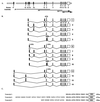Multiple promoters direct the tissue-specific expression of novel N-terminal variant human vitamin D receptor gene transcripts
- PMID: 9724737
- PMCID: PMC27928
- DOI: 10.1073/pnas.95.18.10529
Multiple promoters direct the tissue-specific expression of novel N-terminal variant human vitamin D receptor gene transcripts
Abstract
The effects of 1,25-dihydroxyvitamin D3 [1,25-(OH)2D3] are mediated by the vitamin D receptor (VDR), a member of the nuclear receptor superfamily of transcriptional regulators. We have identified upstream exons of the human (h) VDR gene that are incorporated into variant transcripts, two of which encode N-terminal variant receptor proteins. Expression of the hVDR gene, which spans more than 60 kb and consists of at least 14 exons, is directed by two distinct promoters. A tissue-specific distal promoter generates unique transcripts in tissues involved in calcium regulation by 1, 25-(OH)2D3 and can direct the expression of a luciferase reporter gene in a cell line-specific manner. These major N-terminal differences in hVDR transcripts, potentially resulting in structural differences in the expressed receptor, may contribute to cellular responsiveness to 1,25-(OH)2D3 through tissue differences in the regulation of VDR expression.
Figures



Similar articles
-
Enhancers located within two introns of the vitamin D receptor gene mediate transcriptional autoregulation by 1,25-dihydroxyvitamin D3.Mol Endocrinol. 2006 Jun;20(6):1231-47. doi: 10.1210/me.2006-0015. Epub 2006 Feb 23. Mol Endocrinol. 2006. PMID: 16497728
-
Structural organization of the human vitamin D receptor chromosomal gene and its promoter.Mol Endocrinol. 1997 Jul;11(8):1165-79. doi: 10.1210/mend.11.8.9951. Mol Endocrinol. 1997. PMID: 9212063
-
The caudal-related homeodomain protein Cdx-2 regulates vitamin D receptor gene expression in the small intestine.J Bone Miner Res. 1999 Feb;14(2):240-7. doi: 10.1359/jbmr.1999.14.2.240. J Bone Miner Res. 1999. PMID: 9933478
-
The vitamin D hormone and its nuclear receptor: molecular actions and disease states.J Endocrinol. 1997 Sep;154 Suppl:S57-73. J Endocrinol. 1997. PMID: 9379138 Review.
-
Genomic mechanisms involved in the pleiotropic actions of 1,25-dihydroxyvitamin D3.Biochem J. 1996 Jun 1;316 ( Pt 2)(Pt 2):361-71. doi: 10.1042/bj3160361. Biochem J. 1996. PMID: 8687373 Free PMC article. Review.
Cited by
-
Vitamin D Receptor Polymorphisms Are Associated with Reduced Esophageal Vitamin D Receptor Expression and Reduced Esophageal Adenocarcinoma Risk.Mol Med. 2015 Apr 21;21(1):346-54. doi: 10.2119/molmed.2012.00336. Mol Med. 2015. PMID: 25910066 Free PMC article.
-
Alternative splicing affects the function and tissue-specific expression of the human constitutive androstane receptor.Nucl Recept. 2004 Mar 25;2(1):1. doi: 10.1186/1478-1336-2-1. Nucl Recept. 2004. PMID: 15043764 Free PMC article.
-
Role of Neural Stem Cells and Vitamin D Receptor (VDR)-Mediated Cellular Signaling in the Mitigation of Neurological Diseases.Mol Neurobiol. 2022 Jul;59(7):4065-4105. doi: 10.1007/s12035-022-02837-z. Epub 2022 Apr 27. Mol Neurobiol. 2022. PMID: 35476289 Review.
-
Haplotype and genotypes of the VDR gene and cutaneous melanoma risk in non-Hispanic whites in Texas: a case-control study.Int J Cancer. 2008 May 1;122(9):2077-84. doi: 10.1002/ijc.23357. Int J Cancer. 2008. PMID: 18183598 Free PMC article.
-
Meta-analysis on vitamin D receptor and cancer risk: focus on the role of TaqI, ApaI, and Cdx2 polymorphisms.Eur J Cancer Prev. 2016 Jan;25(1):85-96. doi: 10.1097/CEJ.0000000000000132. Eur J Cancer Prev. 2016. PMID: 25738688 Free PMC article.
References
Publication types
MeSH terms
Substances
Associated data
- Actions
- Actions
- Actions
LinkOut - more resources
Full Text Sources
Other Literature Sources

